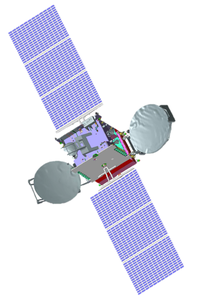GSAT-30
 Render of GSAT-30 spacecraft in deployed configuration | |
| Mission type | Communications |
|---|---|
| Operator | ISRO |
| COSPAR ID | 2020-005A [1] |
| SATCAT no. | 45026 |
| Mission duration | 15 years (planned) 5 years, 1 month, 13 days (elapsed) |
| Spacecraft properties | |
| Bus | I-3K |
| Manufacturer | ISRO Satellite Centre Space Applications Centre |
| Launch mass | 3,357 kg (7,401 lb) [2][3] |
| Power | 6000 watts |
| Start of mission | |
| Launch date | 16 January 2020, 21:05 UTC[4] |
| Rocket | Ariance 5 ECA (VA-251) |
| Launch site | Kourou, ELA-3 |
| Contractor | Arianespace |
| Orbital parameters | |
| Reference system | Geocentric orbit |
| Regime | Geostationary orbit |
| Longitude | 83.0° East [2][3] |
| Transponders | |
| Band | 12 × C-band 12 × Ku-band |
| Coverage area | Asia, Australia |
GSAT-30 is a telecommunications satellite developed by the Indian Space Research Organisation (ISRO).[2][3]
Mission[edit]
The satellite's main communication payload is 12 Ku band transponders for covering Indian mainland and islands and 12 C-band transponders for extended coverage over Asia and Australia. The satellite will act as a replacement for the defunct INSAT-4A.[2] The satellite provides advanced telecommunication services to the Indian subcontinent. It is used for Very-small-aperture terminal (VSAT) networks, television uplinks, digital satellite news gathering, Direct-broadcast satellite (DTH) services and other communication systems. This is the 41st communication satellite launched by ISRO and the 24th launch of ISRO satellite by Arianespace.[5][3][6]
Satellite[edit]
The satellite is based on ISRO's I-3K bus. It was assembled by a consortium of mid-sized industries led by Alpha Design Technologies Ltd. at ISRO Satellite Integration and Test Establishment at Bengaluru.[7]
Launch[edit]
GSAT-30 satellite was launched aboard Ariane 5 launch vehicle (VA251) from French Guiana on 21:05 UTC, 16 January 2020 or 02:35 IST, 17 January 2020.[8] After three orbit raising burns with cumulative duration of 2 hours 29 minutes,[9] GSAT-30 acquired station at 81° East on 25 January 2020.[10]
The launch of the GSAT-30 and GSAT-31 by Arianespace is expected to cost Rs 950 crore.[11]
References[edit]
- ↑ "Display: GSAT-30 2020-005A". NASA. Retrieved 21 February 2020.
 This article incorporates text from this source, which is in the public domain.
This article incorporates text from this source, which is in the public domain.
- ↑ 2.0 2.1 2.2 2.3 "VA251 launch kit" (PDF). Arianespace. Archived (PDF) from the original on 13 January 2020. Retrieved 13 January 2020.
- ↑ 3.0 3.1 3.2 3.3 "GSAT-30 launch kit". ISRO. 13 January 2020. Archived (PDF) from the original on 13 January 2020. Retrieved 13 January 2020.
- ↑ "First Spacebus Neo satellite launched". ESA. 16 January 2020. Retrieved 17 January 2020.
- ↑ "GSAT-30 is installed on Ariane 5 for Arianespace's first mission of 2020". Arianespace. Retrieved 9 January 2020.
- ↑ "ISRO's GSAT-30 Satellite Successfully Launched Aboard Ariane Rocket". The Wire. Retrieved 17 January 2020.
- ↑ "ISRO's GSAT-30 satellite launched, to replace ageing INSAT-4A". The Hindu. 17 January 2020. ISSN 0971-751X. Retrieved 17 January 2020.
- ↑ "India's communication satellite GSAT-30 launched successfully". isro.gov.in. ISRO. Archived from the original on 30 May 2020. Retrieved 16 January 2020.
- ↑ "GSAT-30 update". isro.gov.in. ISRO. Archived from the original on 25 January 2020. Retrieved 31 January 2020.
- ↑ "Historical satellite position data for GSAT-30 for the month of January 2020". satellite-calculations.com. Retrieved 31 January 2020.
- ↑ "ISRO faces costly proposition over recall of GSAT-11". The New Indian Express. Retrieved 6 April 2022.
